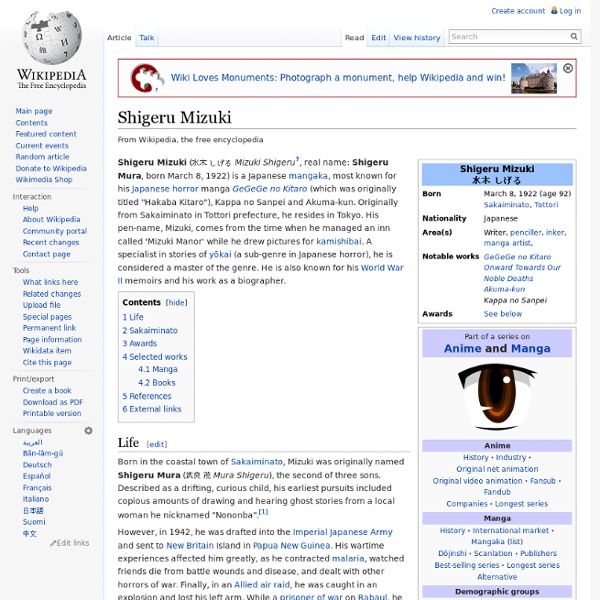Countdown to Mizuki Shigeru’s Showa 1926-1939: A History of Japan
The long wait is almost over! Mizuki Shigeru’s Showa 1926-1939: A History of Japan arrives in stores November 11th!!! I hope everyone is as excited as I am. I guarantee this is one of the most incredible comics you are likely to read this year.
Shigeru Mizuki’s “Onward Towards Our Noble Deaths”
Reviewed by Deji Olukotun Translated from the Japanese by Jocelyne AllenDrawn & Quarterly, 2011 The Japanese story form known as manga—with its extended plotlines and distinct pictorial style—falls somewhere between graphic novel and comic book. Widely read in Japan, where it is a $4 billion industry, manga depicts stories of everything from shogunate sword fights to the lives of high-school tennis stars.
Jacques Rancière
Jacques Rancière (born 1940) is a French philosopher, Professor of Philosophy at European Graduate School in Saas-Fee and Emeritus Professor of Philosophy at the University of Paris (St. Denis) who came to prominence when he co-authored Reading Capital (1968), with the structural Marxist philosopher Louis Althusser.[1] Life and work[edit] Rancière contributed to the influential volume Reading Capital (though his contribution is not contained in the partial English translation) before publicly breaking with Althusser over his attitude toward the May 1968 student uprising in Paris; Rancière felt Althusser's theoretical stance didn't leave enough room for spontaneous popular uprising.[2] Since then, Rancière has departed from the path set by his teacher and published a series of works probing the concepts that make up our understanding of political discourse, such as ideology and proletariat. Influence[edit]
Manga
Manga (漫画, Manga?) are comics created in Japan, or by Japanese creators in the Japanese language, conforming to a style developed in Japan in the late 19th century.[1] They have a long and complex pre-history in earlier Japanese art.[2] The term manga (kanji: 漫画; hiragana: まんが; katakana: マンガ; listen ; English /ˈmæŋ.ɡə/ or /ˈmɑːŋ.ɡə/) is a Japanese word referring both to comics and cartooning. "Manga" as a term used outside Japan refers specifically to comics originally published in Japan.[13]
The Fantastic Shigeru Mizuki English Language Resource Page
A Japanese cartoonist, born in 1924, who lost his left arm in World War II. He is largely responsible for keeping the yōkai tradition alive in Japan, with his distinctive drawings, whimsical comic stories, and general enthusiasm. Yōkai, or youkai, also known as obake or bakemono, are the folk monsters of Japan. They constitute a hundreds-strong menagerie of bizarre and varied creatures. They are magical, nebulous beings that exist in some strange state halfway between spirit and flesh, and are often the physical manifestations of extreme mental states, or the monstrous alteration of some ordinary object, animal, or person. They are just as varied in temperament as they are in form, and range from strange but personable goblins, to harmless pranksters that love scaring people, to dangerous ghouls that feast on human flesh.
Shōwa period
The Shōwa period (昭和時代, Shōwa jidai?), or Shōwa era, is the period of Japanese history corresponding to the reign of the Shōwa Emperor, Hirohito, from December 25, 1926, through January 7, 1989.[1] The Shōwa period was longer than the reign of any previous Japanese emperor. During the pre-1945 period, Japan moved into political totalitarianism, ultranationalism and fascism culminating in Japan's invasion of China in 1937. This was part of an overall global period of social upheavals and conflicts such as the Great Depression and the Second World War. Defeat in the Second World War brought about radical change to Japan.
Ignorant Schoolmaster - Studyplace
From Studyplace Joseph Jacotot (1770-1840) Jacotot was a French instructor who taught subjects as far-ranging as French, literature, mathematics, ideology and law (p. 1). He had a profound realization one time when he had to teach a group of Flemish students French.
Mizuki Shigeru Road・Mizuki Shigeru Museum
Mr.Shigeru Mizuki points at a picture he drew. Mizuki Shigeru Having been interested in Yokai since his boyhood in Sakaiminato, he produced many pieces of work based on the motif of Yokais such as "Ge Ge Ge no Kitaro." He was awarded Shiju Hosho Decoration in 1991, Minister of Edcation Award in 1996 and Kyokujitu Sho Decoration in 2003, for his excellent achievements and cultural contribution. About Yokai(Demon)
Stephen Duncombe



